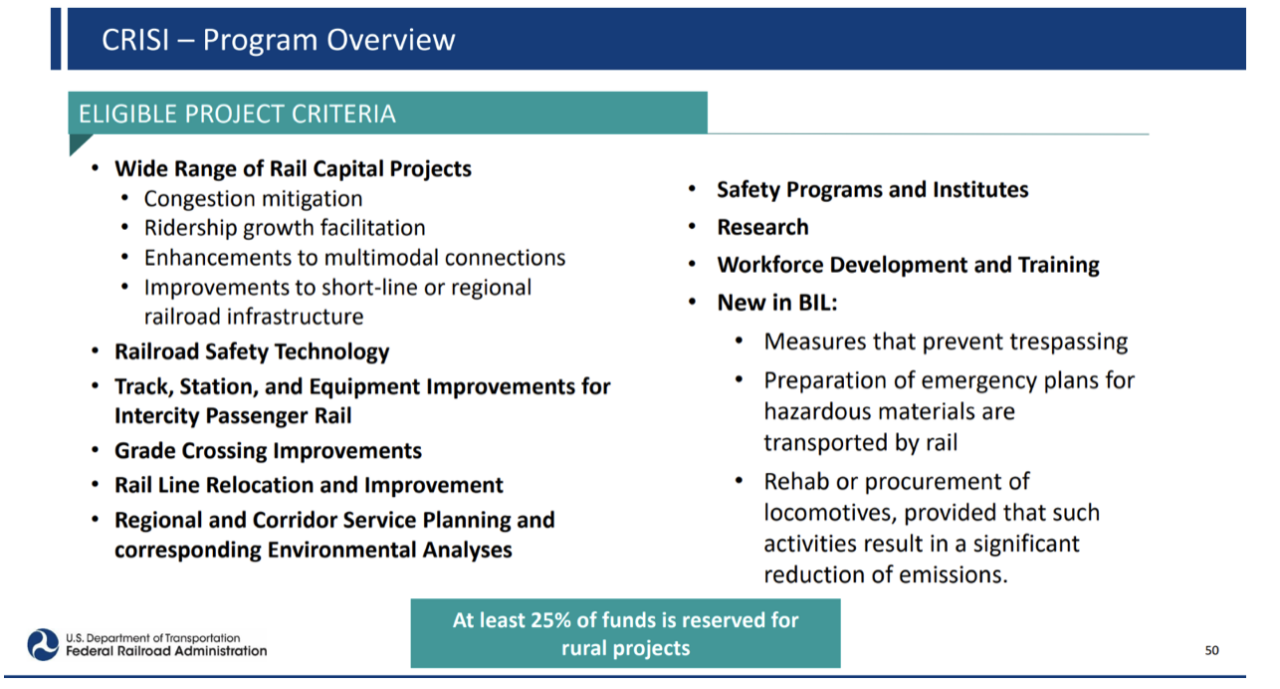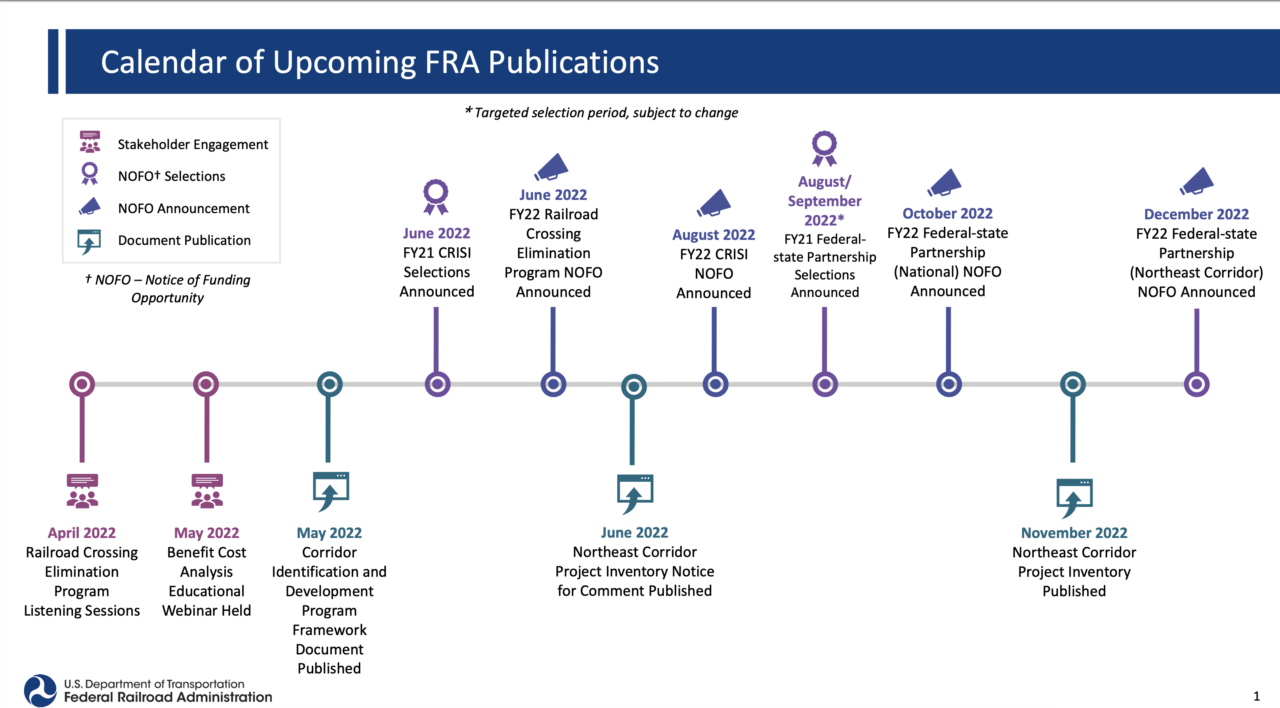Federal Rail Crossing Grants Moving Across America
BY: Brittney D. Kohler, McKaia Dykema, Kyle Funk
Most American cities have active and historic rail train tracks in their backyards. Far before most highways, America’s railroads crisscrossed our country, arriving in small and large cities alike, shaping our travel patterns and land development. However, as America has grown, how many people live near and cross those tracks daily has changed along with how long and often trains are zipping by these communities.
For communities, reaching zero deaths on our roads (known as Vision Zero) also applies to crossing railroad tracks. Sadly, last year there were 881 injuries or deaths at rail crossings in communities. Pedestrians’ deaths accounted for 41 percent of these while 54 percent deaths occurred in motor vehicles as they crossed a railroad.
While many communities have updated their crossings for safety or built over or under to deconflict road and train traffic, far more rail crossings in the U.S. need upgrades to keep the community safe, allow for quiet zones to be established, or even to be eliminated through upgrades.
Rail Grant Opportunities for Communities
America’s communities now have three rail crossing programs they can access directly from the U.S. Department of Transportation (USDOT) as well as each state’s rail safety program. The most well-known is the USDOT’s INFRA grants program (formally, the Nationally Significant Multimodal Freight and Highways Projects program) which just completed an application cycle as part of USDOT’s Multimodal Project Discretionary three-in-one grant application process. INFRA can cover a large number of eligible multimodal uses including rail grade separation projects, but it is highly competitive and often a bigger grant than is needed for a single crossing project. Competitive projects are those that improve safety, generate economic benefits, reduce congestion, enhance resiliency, and hold the greatest promise to eliminate freight bottlenecks and improve critical freight movements.
Due to the outcry for targeted assistance on rail crossings in local communities, Congress formed and appropriated $3 billion in a brand new competitive grant funding in the Railroad Crossing Elimination Grant (RCE) program in the Bipartisan Infrastructure Law (BIL) to improve the safety of people and goods at rail crossings. USDOT’s Federal Railway Administration (FRA) will administer $600 million in RCE grants this year, and USDOT reports these new grants will be available in June. RCE Grants are required by Congress to not be smaller than one million dollars unless they are for planning, and each grant requires a minimum 20 percent non-federal matching share by the entity requesting the grant. Also, at least 20 percent of funds are reserved for projects located in rural areas or on Tribal lands, and even places with very, very few residents have a good shot at these funds – no less than 5 percent of these funds are reserved for projects in counties with 20 or fewer residents per square mile. Local governments, Metropolitan Planning Organizations (MPOs), a mix of local governments or a combo of local and state governments can apply for RCE grants, and partnership can allow for better coordination and sharing the cost burden of the project. It’s important to note that railroads cannot directly apply for this funding, but they can be supportive of applications by eligible entities.
In addition to the RCE program, the Consolidated Rail Infrastructure and Safety Improvement program (CRISI) was an existing FRA program that was renewed. CRISI is receiving $5 billion in total funding through BIL, and Congress could double that if they want to in their annual budgeting. Municipalities that apply for CRISI grants will focus on projects that improve the safety, efficiency, and reliability of intercity passenger and freight rail. The CRISI program Notice of Funding Opportunity (NOFA) for Fiscal Year (FY) 2021 has already been posted and winners for 2022 were announced last week. Local leaders interested in CRISI should be on the lookout in August of this year for the FY 2022 NOFA. While CRISI can be used for a wide range of uses (see chart), this program has a very wide pool of applicants including Amtrak, railroads, and even a university center engaged in rail research making it a competitive program.


If your city is not ready to go after a grant on their own, USDOT’s Federal Highway Administration also provides funds to State Departments of Transportation through the Railway-Highway Crossings (Section 130) Program for the elimination of hazards at railway-highway crossings. From 2000 to 2019, this program is credited with a 32 percent reduction in fatalities at crossings. These funds are distributed by formula to your state, and each state’s FY22 allocation is listed here. Most states open applications or solicitations to access these funds. The Section 130 program funds are eligible for projects at all public crossings including roadways, bike trails and pedestrian paths, but 50 percent is dedicated for the installation of protective devices at crossings. Congress specifically has made grade crossings projects that eliminate hazards posed by blocked crossings due to idling trains eligible. However, the Section 130 program doesn’t offer major construction solutions, such as overpasses or underpasses.
Through these federal rail safety programs cities, towns and villages will be able to eliminate the deaths that occur at dangerous rail crossings in their communities.
Projects Eligible for the New Rail Crossing Elimination Grants
America’s new National Roadway Safety Strategy follows the “Safe System” approach which works by building and reinforcing multiple layers of protection into our infrastructure to: 1) prevent crashes from happening in the first place and 2) minimize the harm caused to those involved when crashes do occur. When humans make mistakes, the consequences should not be deadly.
For rail crossings, most communities using the “Safe Systems” approach are looking for a way to deconflict the road and pedestrian traffic with the trains coming through or to improve the safety at the crossing through upgrades.
To reach that goal, the following are key ways that the RCE grants can be used:
- Over or Under: Railroad track and road grade separation through the use of bridges, embankment, tunnel or combination.
- Move It: Relocating a railroad track.
- Upgrade: Installing or improving signals, signs or protective devices.
- Plan: Planning grants which include the environmental review and design of an eligible project. Not less than 3 percent of the RCE grant funding is for planning grants unless it is in a rural or tribal area where up to 25 percent can be used.
- Technology: Other means to improve the safety if related to the mobility of people and goods at highway-rail grade crossings, including technology solutions.



